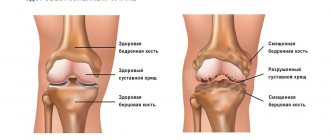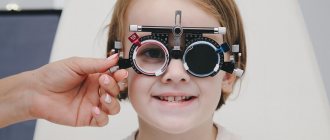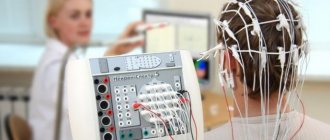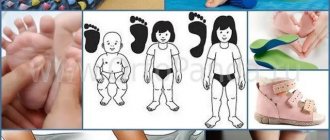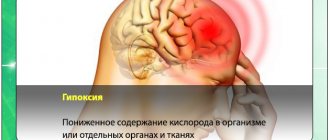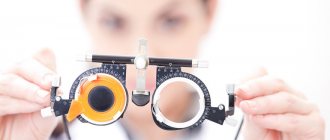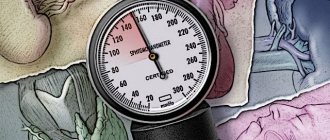Strabismus, or strabismus in scientific terms, is a pathological condition in which one or both eyes deviate from the point of fixation. In the early stages it is not always noticeable; if the form is advanced, it can lead to loss of vision.
It occurs in children and adults, less often in newborns (in the latter group there is a passing “false or imaginary strabismus” due to underdevelopment of the eye muscles).
The causes are varied: congenital and acquired strabismus occurs due to severe visual impairment, underdevelopment or pathology of the visual muscles, mental disorders and severe psychological trauma, some childhood diseases and other factors. Conservative methods are initially used for treatment; if they are ineffective, surgical intervention is used.
Causes
As a result of strabismus, or strabismus, one or both eyes do not concentrate on an object, and there is no complete picture of what is seen. Due to lack of coordination in the functioning of the eye muscles, the brain receives scattered ideas. Normally, in a healthy person, the eyes are fixed at a single point, the brain receives and forms a three-dimensional picture of what it sees.
The occurrence of the disease can be influenced by pathologies of the organ of vision, central nervous system, endocrine system, and mental disorders.
Factors provoking strabismus:
- eye injuries, tumors of the organ of vision;
- pathology of the development of muscle tissue that interferes with eye movement occurs in newborns and children whose mothers suffered from measles, scarlet fever, ARVI, cytomegalovirus and other infectious diseases during pregnancy;
- cataract;
- glaucoma;
- refractive error due to myopia or farsightedness;
- transformation of the vitreous body;
- fear in young children, severe psychological trauma;
- neurosyphilis, multiple sclerosis, encephalitis, blood flow disorders leading to paralysis of the eye muscles;
- increased intracranial pressure;
- pathological conditions in the brain or spinal cord leading to weakening of the eye muscles;
- Disturbances in the functioning of the endocrine system in pregnant women can lead to strabismus in the child.
Strabismus is not a hereditary pathology. Due to complicated heredity, the child may have farsightedness, myopia, and other refractive errors and eye function, which are a risk factor.
Main causes of strabismus
There are a large number of reasons that provoke the manifestation of ophthalmological pathology. They can be divided into two large groups:
Congenital causes
Most congenital causes occur due to illnesses of the parents, as well as due to the unhealthy lifestyle of the latter. All this leads to such consequences as:
- ametropia – manifests itself in the form of hypermetropia, myopia or astigmatism of varying degrees;
- abnormal development and attachment of the muscles responsible for eye accommodation;
- diseases that disrupt the functioning of the central nervous system;
- somatic diseases.
Acquired reasons
Quite often, strabismus can appear due to acquired reasons.
Such reasons include:
- ametropia of moderate and high degree (most often it occurs against the background of excessive fatigue of the visual organs);
- injuries of various types - the most dangerous are head injuries and those that violate the integrity of the outer eye membranes;
- paralysis, paresis;
- frequent stressful situations;
- infectious diseases, manifested in the form of measles, scarlet fever, diphtheria, influenza;
- mental trauma, for example, fear;
- a sharp drop in visual acuity in one eye.
Classification
Depending on its occurrence, strabismus is of two types - congenital and acquired. The first type develops in a child while he is in the womb due to provoking factors.
The eyes have 12 extraocular muscles, and the left and right eyes have 6 muscles each. Each of them is responsible for turning the eyeball to the right, left, up or down. When the work of the extraocular muscles is uncoordinated and there is a lack of synchronization between them, strabismus is detected. Depending on the dysfunction of any of these muscles, the following types of strabismus occur:
- exotropia, or divergent strabismus;
- convergent (internal) strabismus;
- vertical strabismus;
- mixed form.
With exotropia, the eyes look “outward” and focus in different directions. The convergent form is also called isotropy. It is characterized by focusing the eyes in the opposite direction, on the bridge of the nose. With the vertical variety, squinting eyes are observed in a vertical plane - up or down.
Acquired strabismus can occur in one of three forms:
- constant;
- temporary due to alcohol intoxication or the effects of narcotic and psychotic substances, severe relaxation or illness;
- sensory – a harbinger of decreased vision.
Another classification of strabismus divides the disease into imaginary, hidden and true types. If the development of the oculomotor muscles of the right and left eyes is unequal, latent strabismus is diagnosed, which is noticeable when covering the healthy eye with a hand.
Symptoms
The main symptom of the disease, regardless of its type, is the asymmetrical location of the iris and pupil relative to the palpebral fissure. Symptoms of strabismus may vary depending on the type of disease.
Symptoms of paralytic strabismus include:
- limited or complete lack of mobility of the eye, which is deviated in the direction of the damaged eye muscle;
- the occurrence of diplopia;
- frequent headaches that disappear after closing the affected eye;
- inability to assess the location of a visible object.
The concomitant type by :
- absence of diplopia;
- almost identical and unlimited eye movements, both healthy, with the help of which the image is recorded in front of the patient’s eyes, and squinting;
- preservation of the functions of the extraocular muscles;
- equal indicators of the angles of primary and secondary deflection.
If one of the above symptoms is detected, you must contact a highly qualified specialist for diagnosis. This will help determine the treatment method for strabismus.
Concomitant strabismus
It is characterized by identical strabismus angles, insufficient development of the extraocular muscles of both eyes and the absence of double vision.
According to the mechanism of development, strabismus is divided into 3 subtypes: accommodative, partially accommodative and non-accommodative. In the first subtype, the disease is preceded by farsightedness, myopia and other accommodation disorders. Glasses are required for treatment. In the second subtype, partial vision loss is diagnosed. The non-accommodative type of strabismus is not easily identified and eliminated, since it occurs in the child at birth due to sudden injuries and blows suffered by the mother and infectious diseases.
The opposite of concomitant strabismus is the paralytic type, accompanied by double vision. It occurs due to the inability to move the eyes, leading to headaches, fatigue and general malaise, and partial or complete paralysis of the eye muscle tissue.
False strabismus (pseudoesotropia)
It is important not to confuse false strabismus or all-strabismus with true strabismus.
There are two types of pseudoesotropia:
Imaginary (apparent) strabismus
This effect occurs due to the structural features of the eyeball. When the angle between the optical and visual axis is small (no more than 3-4°), then the eyes are parallel. If the size of this angle is significant (sometimes up to 10°), then it seems as if the person is squinting his eyes and the effect of heterotropy is obtained. However, binocular vision is preserved and there is no need for treatment.
Hidden strabismus (heterophoria)
There are two concepts: orthophoria and heterophoria. The first is excellent muscular balance of the eyes. By the second concept, heterophoria, ophthalmologists mean different forces of action of the extraocular muscles. In this case, muscle weakness may manifest itself visually and the visual line of one of the eyes may deviate outward (exophoria), inward (esophoria), downward (hypophoria) or upward (hyperphoria).
If a person fixes his gaze on an object, then the eyeballs will be located completely parallel, and with, for example, thoughtfulness, i.e., defocused gaze, heterophoria is observed.
If a patient has a high degree of heterophoria, this may cause symptoms such as:
- headache;
- nausea;
- fatigue;
- diplopia (split objects);
- ametropia (myopia, hypermetropia, astigmatism).
To identify hidden strabismus (heterophoria), you need to turn off one of the eyes from binocular vision. Binocular vision completely corrects this feature, so treatment is not needed here.
Imaginary strabismus
This type occurs in newborns and can persist for up to 4 months due to the underdevelopment of the optic nerve and the inability to focus the gaze. It does not require observation or correction.
To develop the eye muscles, it is necessary to show the child objects of predominantly black and white colors, from a month - green and yellow colors at a distance of 15-20 cm. After focusing the gaze on the object, it should be slowly moved to the sides, up or down.
If the condition persists after 4 months, a visit to an ophthalmologist is required.
Diagnostics
To diagnose strabismus, it is necessary to collect an anamnesis, the timing of the onset of the disease, and establish a connection between strabismus and previous or existing diseases. Biometric studies, a test ophthalmological examination, a refractive examination are carried out and the ophthalmologist examines the structures of the eye.
When making a diagnosis, the angle of strabismus is measured and the volume of accommodation is determined. If a paralytic type of pathology is diagnosed, additional consultation with a neurologist and a computer examination is required.
Diagnosis of strabismus
In order to identify strabismus and make a diagnosis, visual acuity and refraction are determined, the angle at which the eye squints, and binocular vision is examined. The degree of damage, the presence of amblyopia, what caused the strabismus, and the patient’s age must be taken into account. Treatment begins early, before irreversible changes begin.
When observing children, we see forced squinting; the child turns and tilts his head to the side in order to see better. When strabismus occurs in adulthood, a split picture is observed.
Treatment
Strabismus therapy is aimed at restoring normal, binocular vision. It includes several methods. With successful treatment, stable binocular vision, high visual acuity, and symmetry of eye position are restored.
Correction with glasses and lenses
Necessary for any type of strabismus. Especially with accommodation, when the provoking factor for the disease was myopia, farsightedness or other accommodation disorders.
The purpose of optical correction with the help of selected contact lenses or glasses is to restore visual acuity, eye similarity and accommodation.
Hardware treatment
Using special devices, the visually impaired or amblyopic eye is stimulated. Computer programs, Synoptophore, photo, laser and magnetic stimulation, Amblyocor, vacuum ophthalmic massage are common.
Wearing an occlusive dressing
A special bandage is fixed on the healthy eye, the person sees objects with a squinting eye. This is done with the aim of increasing the load on the pathological eye, excluding the fixing, healthy eye from the vision process. Hardware treatment and the use of special computer programs are based on this principle.
Surgery
A treatment option if conservative treatment for a year and a half has not produced positive results and improvement in the patient’s condition. The most optimal age for surgical intervention is 3-5 years. First, the tendon is cut or a muscle is transplanted to weaken muscle regulation, then in the second stage the action of the extraocular muscle is strengthened by shortening it.
The disadvantage of surgical treatment is the possibility of complications (poor vision and blindness, bleeding, infection, insufficient or excessive correction of strabismus).
Strabismus - symptoms and treatment
Drug therapy accompanies each complex of strabismus treatment to varying degrees. It is recommended to establish the correct lifestyle and activities, restorative treatment and health-improving measures (sanitation of the nasopharynx and oral cavity, deworming, reduction of allergic conditions, etc.). In case of non-accommodative strabismus, strictly follow the neurologist's instructions.
1. Glasses (optical correction). Selection of glasses that maximally correct ametropia in conditions of cycloplegia, for constant wear. In practice, wearing corrective glasses in young children often restores binocular vision and eliminates strabismus.[5]
In my practice I use the following prescriptions with good positive results:
For convergent strabismus:
- High and moderate hypermetropia; high myopia, I prescribe glasses 1.0 D weaker than refraction due to cycloplegia to maintain the tone of the ciliary muscle;
- Mild hypermetropia, complete correction or 0.5 D weaker than refraction due to cycloplegia. For mild myopia, I do not recommend glasses, since under natural conditions there should be tension in accommodation and convergence.
For divergent strabismus:
- Myopia of all degrees, complete correction of refraction due to cycloplegia, causing tension of accommodation and convergence.
- High degree of hypermetropia and low vision, spectacle correction is 2–3.0 D weaker than refraction for cycloplegia.
2. Pleoptic treatment. Consists of treatments for amblyopia. Improving visual acuity of a squinting eye. To do this, we assign occlusion of the better eye. In my practice, I use direct sealing of the eye; I refused to use spectacle occluders due to the slow and unstable positive results. Especially in children 2–4 years old. We carry out occlusion for a long time (2–6 months) with periodic, once every 2 weeks, monitoring of vision in both eyes. For children 3–4 years old, the penalization technique is used. We create artificial anisometropia by assigning hypercorrection to the better eye and full correction to the amblyopic eye. In children 4–5 years old, we achieve maximum equalization of visual acuity in both eyes.[1][3]
3. Orthoptic treatment, or vision therapy. It begins after creating a relative balance of vision in both eyes of at least 0.4 D in children from 4–5 years of age. Restoring the binocular vision reflex.[2][3]
Preoperative orthoptic exercises are conventionally divided into sensory (goal: elimination of functional scotoma, anomalies of retinal correspondence and restoration of fusion at the angle of strabismus) and motor (goal: development of muscles - oculomotors, the functions of which in the case of long-standing concomitant strabismus are often impaired due to changes in the periocular tissues ).[4]
4. Diploptic treatment . Restoration of binocular and stereoscopic vision in natural conditions.[1]
5. Surgical treatment. Performed to relax muscle action (recession) or enhance this action (resection). During the operation, the surgeon makes the final decision on correcting the position of the eyes.[4] Surgery of the extraocular muscle is the most effective method of treating strabismus in children and adults with the obligatory condition of a preliminary therapeutic course of treatment.
6. Postoperative pleoptoorthoptic treatment. It is carried out to eliminate possible post-operative partially accommodative strabismus. If necessary, the previously prescribed correction is strengthened.[4]
7. Stereoscopic treatment. Restoration of the complex mental act of awareness of objects and their parts in their relative positions.[2]
8. Medicines. Drug treatment gives a weak positive effect, but together with spectacle correction and hardware treatment, the effectiveness in treating strabismus in children is more than 80%. Phenylephrine eye drops can achieve long-term positive therapeutic results. When strabismus develops against the background of myopia, fenicamid and midrimax are recommended.
9. Chemodenervation is a method of surgical treatment using botulinum toxin in our country for the treatment of strabismus in children. In adults, the effectiveness of such treatment is high if this chemodenervation is recommended by a doctor after a detailed examination. The treatment method is used mainly for paralytic types of strabismus.
10. Gymnastics for the eyes. In children, strabismus is diagnosed at 2-3 years of age. At this age, it is difficult for them to explain the rules of eye gymnastics; children will be able to perform the exercises from the age of 5. Gymnastics can complement the main treatment.
11. Hardware treatment is a mandatory method of treating strabismus in children. Exceptions are allowed only for medical reasons. In adults, hardware treatment can reduce rehabilitation time.
12. Nutrition and vitamins. A varied diet is encouraged. In addition to the main treatment, you can use vitamin complexes: “Vitrum Baby”, “Blueberry Forte”, “Blueberry Vital”, “Vivasan-syrup”, “Visualon”.
13. Traditional medicine methods do not have sufficient evidence of effectiveness and safety.
Prevention
To prevent the development of strabismus in an adult or child, before planning a pregnancy, it is important to be examined, identify the presence of ophthalmological diseases and correct the condition. Do not be in areas of epidemics during the season of colds, flu, or other infectious diseases.
One of the preventive measures is regular visits to the doctor for examination.
If strabismus is detected, it is important not to be shy, adhere to the prescribed treatment, and perform gymnastics to strengthen and move the extraocular muscles. For example, look into the distance, then examine objects in the distance, draw a bow, a Christmas tree, or other objects with your gaze.
To hide squint, women can learn makeup techniques that don't focus on the eyes.
Expert opinion
Kiryukhina Svetlana Lvovna
Ophthalmologist of the highest category in the children's department, ophthalmic surgeon, Candidate of Medical Sciences
Treatment of strabismus is a long process, and surgical treatment alone is not enough. It is not enough to return the eye to the correct position, you need to teach the body how to use it correctly. This is achieved by regular training: visual gymnastics, development and consolidation of binocular vision, correction of amblyopia.
And while it is still possible to explain to an adult the need for regular exercise, children quickly get bored with it. In this case, the success of treatment depends on the parents, who must monitor the implementation of all prescriptions of the attending physician.
Cost of basic services
| Service | Price, rub.) | By map |
| Therapeutic programs | ||
| Conservative treatment of refractive errors (5 sessions) ? A course of hardware and physiotherapeutic procedures aimed at treating myopia, farsightedness, and astigmatism. | Price 5750 ₽ | By map 5250 ₽ |
| Conservative treatment of refractive errors (10 sessions) ? A course of hardware and physiotherapeutic procedures aimed at treating myopia, farsightedness, and astigmatism. | Price 11500 ₽ | By map 10500 ₽ |
| Pleoptic treatment (5 sessions) ? A course of hardware treatment aimed at increasing the sharpness of the worse-seeing eye. | Price 7950 ₽ | By map 7400 ₽ |
| Pleoptic treatment (10 sessions) ? A course of hardware treatment aimed at increasing the sharpness of the worse-seeing eye. | Price 15900 ₽ | By map 14800 ₽ |
| Orthoptic treatment for younger age group (5 sessions) ? A course of hardware treatment aimed at improving the joint functioning of the eyes. For patients under 6 years of age | Price 7950 ₽ | By map 7400 ₽ |
| Orthoptic treatment for younger age group (10 sessions) ? A course of hardware treatment aimed at improving the joint functioning of the eyes. For patients under 6 years of age | Price 15900 ₽ | By map 14800 ₽ |
| Orthoptic treatment for older age group (5 sessions) ? A course of hardware treatment aimed at improving the joint functioning of the eyes. For patients over 6 years old | Price 8900 ₽ | By map 8300 ₽ |
| Orthoptic treatment for older age group (10 sessions) ? A course of hardware treatment aimed at improving the joint functioning of the eyes. For patients over 6 years old | Price 17800 ₽ | By map 16600 ₽ |
| Pleopto-orthoptic treatment younger age group (5 sessions) ? A course of hardware treatment aimed at restoring binocular function with changes in the nature of vision and treating amblyopia. For patients under 6 years of age | Price 8500 ₽ | By map 8000 ₽ |
| Pleopto-orthoptic treatment younger age group (10 sessions) ? A course of hardware treatment aimed at restoring binocular function with changes in the nature of vision and treating amblyopia. For patients under 6 years of age | Price 17000 ₽ | By map 16000 ₽ |
| Pleopto-orthoptic treatment, older age group (10 sessions) ? A course of hardware treatment aimed at restoring binocular function with changes in the nature of vision and treating amblyopia. For patients over 6 years old | Price 18800 ₽ | By map 17400 ₽ |
| Pleopto-orthoptic treatment older age group (5 sessions) ? A course of hardware treatment aimed at restoring binocular function with changes in the nature of vision and treating amblyopia. For patients over 6 years old | Price 9400 ₽ | By map 8700 ₽ |
| Orthoptic-diploptic treatment (10 sessions) ? A course of hardware treatment aimed at restoring binocular function in patients with a minimal angle of strabismus. For patients over 6 years old | Price 19000 ₽ | By map 18000 ₽ |
| Orthoptic-diploptic treatment (5 sessions) ? A course of hardware treatment aimed at restoring binocular function in patients with a minimal angle of strabismus. For patients over 6 years old | Price 9500 ₽ | By map 9000 ₽ |
| Orthoptic course of treatment (stage II) (5 sessions) ? A course of hardware treatment after surgery for strabismus. | Price 4850 ₽ | By map 4550 ₽ |
| Orthoptic course of treatment (stage II) (10 sessions) ? A course of hardware treatment after surgery for strabismus. | Price 9700 ₽ | By map 9100 ₽ |
| Postoperative course of orptoptic treatment for patients operated on for strabismus in other clinics (10 sessions) ? A course of hardware treatment after surgery for strabismus. | Price 28200 ₽ | |
| Comprehensive vision activation program (10 sessions) ? A course of hardware treatment aimed at improving the blood supply to the eye and activating the work of the central parts of the visual analyzer. | Price 19200 ₽ | By map 17800 ₽ |
| Comprehensive vision activation program (5 sessions) ? A course of hardware treatment aimed at improving the blood supply to the eye and activating the work of the central parts of the visual analyzer. | Price 9600 ₽ | By map 8900 ₽ |
| Program "MAXIMUM" (5 sessions) ? The most effective course of hardware and physiotherapeutic treatment, selected individually according to medical indications | Price 11500 ₽ | By map 10900 ₽ |
| Program "MAXIMUM" (10 sessions) ? The most effective course of hardware and physiotherapeutic treatment, selected individually according to medical indications | Price 23000 ₽ | By map 21800 ₽ |
| “MAXIMUM” program with orthoptic slope (5 sessions) ? The most effective course of hardware and physiotherapeutic treatment, selected individually according to medical indications for patients with impaired binocular vision | Price 11750 ₽ | By map 11100 ₽ |
| “MAXIMUM” program with orthoptic slope (10 sessions) ? The most effective course of hardware and physiotherapeutic treatment, selected individually according to medical indications for patients with impaired binocular vision | Price 23500 ₽ | By map 22200 ₽ |
| Treatment with the “Rucheek” device (10 sessions)? The device is used to train the accommodation mechanism | Price 6400 ₽ | By map 6050 ₽ |
| Treatment with the “SINOPTOPHOR” device (10 sessions)? The device is used in a complex of therapeutic training for strabismus. | Price 14150 ₽ | By map 13200 ₽ |
| Treatment with the FORBIS device (10 sessions)? The device is used to train the accommodation mechanism and restore binocular vision. | Price 14150 ₽ | By map 13200 ₽ |
| Treatment with the REAMED device (10 sessions)? The device allows you to normalize the functioning of the central parts of the brain responsible for vision, for the prevention and treatment of spasms of accommodation, amblyopia, and refractive errors. | Price 10600 ₽ | By map 9900 ₽ |
| Massage of the cervical-collar area (1 lesson) ? Massage is effective in complexes of therapeutic and preventive procedures | Price 880 ₽ | By map 820 ₽ |
| Orthokeratological course of vision correction, one year, 2 eyes (standard lenses)? Corneal refractive therapy using orthokeratological night lenses for short-term vision correction in myopia | Price 32400 ₽ | |
| Orthokeratological course of vision correction, one year, 1 eye (standard lenses)? Corneal refractive therapy using orthokeratological night lenses for short-term vision correction in myopia | Price 24200 ₽ | |
| Orthokeratological course of vision correction, one year, 2 eyes (non-standard lenses)? Corneal refractive therapy using orthokeratological night lenses for short-term vision correction in myopia | Price 38500 ₽ | |
| Orthokeratological course of vision correction, one year, 1 eye (non-standard lenses)? Corneal refractive therapy using orthokeratological night lenses for short-term vision correction in myopia | Price 26400 ₽ | |
| Selection of ortholenses? Corneal refractive therapy using orthokeratological night lenses for short-term vision correction in myopia | Price 4950 ₽ | |
| Treatment of strabismus | ||
| Surgical treatment of strabismus, stage 1 (one eye)? Surgical treatment of strabismus is used in cases where conservative methods fail to achieve symmetrical position of the eyes. The first stage is aimed at reducing the angle of strabismus. | Price 64500 ₽ | By map 60500 ₽ |
| Surgical treatment of strabismus, stage 1 (two eyes)? Surgical treatment of strabismus is used in cases where conservative methods fail to achieve symmetrical position of the eyes. The first stage is aimed at reducing the angle of strabismus. | Price 120000 ₽ | By map 112000 ₽ |
| Surgical treatment of strabismus, stage 2 (one eye)? Surgical treatment of strabismus is used in cases where conservative methods fail to achieve symmetrical position of the eyes. The first stage is aimed at completely eliminating strabismus. | Price 30000 ₽ | By map 24000 ₽ |
| Surgical treatment of PARALYTIC strabismus? Surgical treatment of paralytic strabismus is used in cases where conservative methods fail to achieve symmetrical eye position. | Price 105000 ₽ | By map 99000 ₽ |
Full price list The cost of microsurgical operations is indicated for one eye
Full price list
Useful video
The video tells who is more likely to experience strabismus, what visual features are observed, and how others treat them.
Author's rating
Author of the article
Alexandrova O.M.
Articles written
2100
about the author
Was the article helpful?
Rate the material on a five-point scale!
( 2 ratings, average: 3.00 out of 5)
If you have any questions or want to share your opinion or experience, write a comment below.
How it manifests itself
One of the main signs of strabismus is the appearance of the eyes, but it is not always reliable, since in children in the first year of life the strabismus is imaginary. Strabismus in children of the first year of life can be considered true only if one eye is constantly deviated to the side; this may indicate paralytic strabismus.
When this sign appears, you need to pay attention to the position of the child’s head, it will be forced. The child will constantly keep his head on his side or turn it to the side, this will compensate for the split image, decreased vision, headache, and the child may squint.
